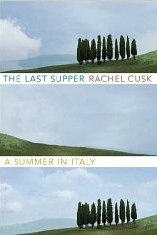The Last Supper
I knew nothing about this brand-new account of a writer’s move to Italy. As I was about to embark on a visit to Italy (albeit only for a week and not, as Cusk intended, to transform Existence) this attractive book seemed ideal plane reading.It’s a studiously old-school travel story, moving from I Hate It Here to Amusing Vexations En Route to Colorful Old Townspeople And Their Lovely Daughters.
The writing is studiously fine. Sometimes, it slips the leash and runs around the garden. Of the Uffizi:
Inside, the building is deep and tenebrous and hushed.
My apartment is dark as well as damp. And this is 2009: readers who buy books like this one and for whom “tenebrous” holds no terrors have a pretty decent chance of having been to Florence. I’ve known some deep, tenebrous, and hushed places, and theUffizi doesn't come close to the Pearl Street Bar after Pedro’s disaster, or the great kiva at Aztec NM, or the basement herpetological collection of the old Chicago Academy of Sciences.
Silvio is as hard to corner as the hare I sometimes see standing proud and alert in the empty garden, that bounds away at the slightest noise. But one day I offer him coffee, and though he looks at me gravely he does not refuse.
In Italy, even the wild rabbits drink espresso!
But the real problem here is that the trip (and thus the book) is patently an occasion for short essays on Various Topics, and I’m never confident that Cusk’s impressions are substantial. The notes on painting are good, but are they better than Ruskin, or Vasari? We need a bit more assertiveness, a reason to stop and regard these ideas, a sense that they take into account what others already have proposed. There’s a bit on Italian food considered as sentimental, but the argument seems thin, focusing more on “Italian” food as Britons view it rather than on any particular Italian cuisine. A lot of what Cusk views as typically Italian (a focus on one or two ingredients, simplicity, and freshness) seems to apply just as well to many regions of France, not to mention American Regional or New Australian.
Twice, I simply don’t know what is going on. The author is travelling with her daughters, and at a hotel they have met two American girls their own age.
Later, I hear the American girls talking about their mother. She’s really sick, the older one says. I sit up: I want to explain to my daughters what that means.
I want her to explain it to me, too, because – depending on age and region and tone of voice, I could see these words indicating that (a) Mom is dying of leukemia, (b) Mom is addicted to controlled substances, (c) Mom is a suspicious and restrictive disciplinarian with whose religious fanaticism my sister and I do agree, (c) Mom is having an affair, which is gross, (d) Mom has a wicked sense of humor, or (e) my sister and I are 11 and 13.
There’s a similar passage on the subject of a fresco at Pompeii (The Catechism With Young Girl Reading), which strikes me as an innocuous decoration and which Cusk sees as depicting “the mystery and brutality of the pre-Christian world.” I think this is a stretch: even if we assume (as I guess Cusk assumes) that the next step in initiation involved sex with the priests, it would have been consensual by the standards of the time, the girl is old enough by the standards of the time, and it’s Someone Else’s Religion. Besides, where’s the evidence? Herodotus, maybe, but he's writing of other people and he's five centuries earlier. Maybe at these initiations they just taught you the secret handshake, or showed you pictures, or taught you how to dance.
Between many Madonnas and a visit to Assisi, Cusk begins to build an inchoate argument for appreciating Renaissance art while holding reservations about Catholicism. In principle, this could be interesting. In practice, it doesn’t work. Apparently, she was shhhh'd at the Basilico di San Francesco by crowds more interested in relics and masses than in frescoes, and I’m not unsympathetic. But still, they’re here for the Intended Purpose, and she’s there to look at their paintings; one could wish for more grace and generosity of spirit, but she’s a tourist and she’s a foreigner and she’s in the way. The effect, in this old-fashioned book, is an (presumably unintentional) return to the spirit of the 17th or 18th century Briton In Italy, enjoying the paintings while deploring popish superstition and ceremony. But Gibbon does it better with his barefoot monks in the Temple of Jupiter, and he only mentions it to explain how he came to write The Decline and Fall.
But, you know: this was one of my least favorite books for the last year or two, and look how much fun I had!
